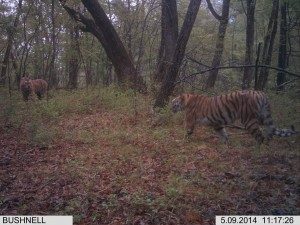 Two aspects of ZSL’s Amur tiger conservation project in the Russian Far East are population monitoring and wildlife health studies. We use camera trapping as a method to monitor tigers and recently expanded it for use in understanding the health status of other representatives of local fauna. As the project veterinarian, I oversee wildlife health activities and I do not deal with field aspects of camera traps too much, but last winter our entire crew (including the database manager) were looped into setting up and checking camera traps on the territory of Lazovsky Reserve.
Two aspects of ZSL’s Amur tiger conservation project in the Russian Far East are population monitoring and wildlife health studies. We use camera trapping as a method to monitor tigers and recently expanded it for use in understanding the health status of other representatives of local fauna. As the project veterinarian, I oversee wildlife health activities and I do not deal with field aspects of camera traps too much, but last winter our entire crew (including the database manager) were looped into setting up and checking camera traps on the territory of Lazovsky Reserve.
The experience made me realise that organizing camera trapping surveys is actually not easy stuff. It requires that you be intelligent (to set up camera trap in appropriate places) and physically fit (to get to remote places for camera trap set up). Despite the toughness of the process, it is a very exciting and enjoyable event because you have an opportunity to be looped into the life of individual tigers (when they get photographed) and become closer to these unique animals.
For example, the tigress Sabrina (see photographs) deserves special attention because of her interest to people – during six years she was photographed by camera traps many times near a reserve cabin where inspectors and scientists often saw her first hand, but she never bothered anybody. Despite such unusual behaviour, this tigress is a ‘Mother-heroine’ as she had two litters, each with three cubs in a relatively short period – two years – and at least two cubs from her first litter have survived to adopt a solitary life. Resident male Yasha also deserves our attention because for many years he has been Sabrina’s mate, protecting her and her cubs from marauding non-resident males.This high rate of reproduction and longevity could only be possible with adequate prey and protection from poaching and is evidence that our project is having its intended effect.
As a vet and person that cares mainly about scientific facts (like evidence of disease, population abundance, density etc.) I did not pay too much attention to the individual history of animals we study. In my honest opinion it is a little bit of a mistake, because science and abstract desire of conservation of the species is not so effective, if not impossible, without understanding of problems of particular representatives of this species. It gives you a real motivation and proves again how it is important for wildlife vets to work together with wildlife biologists – the people who usually know each animals ‘by face’ on their study area.
Misha Goncharuk

